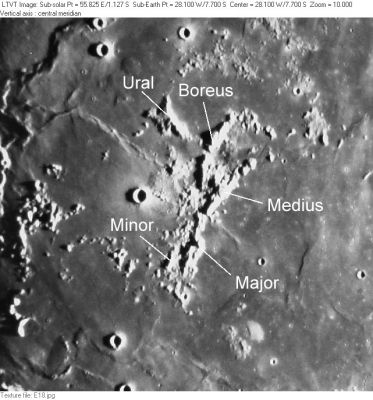Montes Riphaeus
Contents
Montes Riphaeus and Montes Ural
|
Lat: 7.7°S, Long: 28.1°W, Diam: 189 km, Height: 1.24 km, Rükl: 41 |
Consolidated Lunar Atlas Plate E18 In the initial IAU nomenclature of 1935, the feature now known as Montes Riphaeus was called "Riphaeus" and included the separately-named parts, Ural, Riphaeus Boreus, Riphaeus Medius, Riphaeus Major, and Riphaeus Minor, as shown. These names were dropped in the revisions of the early 1960's.
Is the east-southeastern arc-shaped section of Montes Riphaeus a very small part of a much larger circle-shaped formation? (the Cognitum-basin perhaps...).
Images
LPOD Photo Gallery Lunar Orbiter Images Apollo Images
Maps
(LAC zone 76A4) LAC map Geologic map LM map AIC map
Description
Description: Elger
(IAU Directions) THE RIPHAEAN MOUNTAINS.--a remarkably bright group, occupying an isolated position in the Mare Procellarum south of Landsberg, and extending for more than 100 miles in a meridional direction. They are most closely aggregated at a point nearly due east of Euclides, from which they throw off long-branching arms to the north and south, those on the north bifurcating and gradually sinking to the level of the plain. The loftiest peaks are near the extremity of this section, one of them rising to 3,000 feet. Two bright craters are associated with these mountains, one nearly central, and the other south of it.
Description: Wikipedia
Additional Information
Depth data from Kurt Fisher database
- Cherrington, 1969: 1.24 km
The arc of the Riphaeus range and the absence of the basin's complete circle on SLC map E5
- Several sections of the SLC map (System of Lunar Craters, 1966) show the complete circles of bay-shaped craters and basins such as the curved Jura mountain range at Sinus Iridum (E2). One should expect to see the complete circle of the arc of Montes Riphaeus on Mare Cognitum (E5), but it doesn't...
- Don Davis, one of the space artists who made splendid illustrations for Carl Sagan's COSMOS TV-series and its accompanying book (1980), created wonderful paintings of the formation of Mare Imbrium and the region south of it (including Mare Cognitum) This series of paintings (which could be called The Imbrium event) also shows the formation of the large impact crater responsible for the Riphaeus range, which is nowadays the crater's (still existing) western part. See page 89 in Carl Sagan's book COSMOS.
Nomenclature
- Named after the range in Asia (now known as the Ural Mountains).
- Called Peninsula Deliriorum by Riccioli.
- Both Virgil and Pliny referred to a semi-mythical range of mountains by this name, thought from their descriptions to have been located in northern Asia or Scythia. It was also regarded as the source of the north winds. The name Riphaeus was first used by Gassendi for the mountain range now known as the Apennines (Whitaker, p. 33).
- According to Whitaker (p. 209), of the many names used by Hevelius, Montes Riphaei is one of just ten that have survived into modern usage; although Hevelius used it for a range of mountains near Cleomedes. It is unclear from Whitaker's book how it came to be associated with the current hills, but Who's Who in the Moon attributes this usage to Mädler. It also asserts that a better spelling is Rhiphaeus. - Jim Mosher
- The subdivision of Riphaeus into Ural and four other separately named parts was introduced by Krieger and König (Whitaker, p. 226), and adopted by Blagg and Müller as part of the original IAU-approved nomenclature of 1935. The separate names were deleted by Kuiper et al., whose changes to Blagg and Müller (published in the Photographic Lunar Atlas) were approved by the IAU in 1961. The surviving name was Latinized in IAU Transactions XIIB (1964).
- Krieger's and Konig's nomenclature of the whole Riphaeus/Ural complex is seen Krieger's map of that area reproduced on page 164 of Whitaker's book. The names are: Antural, Cissemlja, Jekaterinburg Damm, Jekaterinburg Pass, Karische Strasse, Semlja Nowaja, Riphaeus Boreus, Riphaeus Major, Riphaeus Medius, Riphaeus Minor, Sinus Semlja, Transsemlja, Ural, and probably the name "Zeno" (for Euclides M). Note that Semlja Nowaja is a single word and not two separate nams ("Semlja" and "Nowaja") as printed in Whitaker's Appendix N, and on page 118 of Volume III of the Transactions of the IAU, in which the "Nowaja" part was printed as "Norvaja"! -- see the Wikipedia page Novaya Zemlya (Nova Zembla/ Neues Land/ New Land). "Zeno" is not mentioned in Whitaker's Appendix N, although there is something "Zeno"-like on Krieger's map! Research and investigations: Danny Caes.
- The northwestern part of Montes Riphaeus' which is called Montes Ural on several moonmaps such as HALLWAGs, was called Transsemlja by Krieger. His Ural was the small part south of Transsemlja and northeast of Euclides. In the Times Atlas of the Moon, Chart 67, Krieger's Transsemlja is called Euclides Delta, while on AIC-76A (the map known as Euclides P) it is called Euclides Zeta. - DannyCaes Sep 28, 2013
- Still strange to see the names of two northern mountain ranges (Riphaeus and Ural) located slightly south of the lunar equator! - DannyCaes Oct 17, 2015
LPOD Articles
Bibliography
- Ewen A. Whitaker. Mapping and Naming the Moon.
- Apollo Over the Moon -- A View from Orbit, Chapter 2: Regional views, Figure 26. Chapter 4: The Maria (Part 3), Figure 86.
